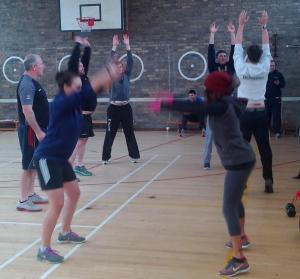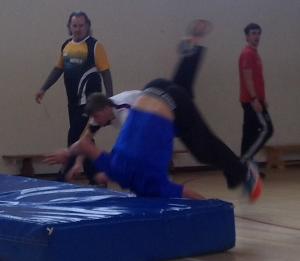Getting started in strength and conditioning
 S&C qualification:”There is more to circuit training than just getting tired”
S&C qualification:”There is more to circuit training than just getting tired”
was something I kept explaining to coaches on the recent level 1 coaching strength and conditioning for sport course.
I always say that any idiot can get people tired (and plenty do), but if you want your athletes to progress effectively, then there has to be a plan.
The group of coaches on this course came from many different sports and were used to doing things a certain way. Whilst everyone wants to know “is this a good exercise?“, few ask “what is the aim of this session and how can I plan accordingly?”
Power circuits

Specific circuits for Netball
People like using the word power in training programmes. So I see under aim “A power endurance circuit for netball players” and then the session designed as 1 minute of work, 10 seconds of rest for a sequence of 8 exercises!
The exercises then include squat jumps and the plank (I saw this in action recently with a so called strength and conditioning coach taking the “High performance ” netball squad!).
- I have no idea what power endurance means.
- No one does squat jumps well for a minute.
- Plank: really? Hardly helps develop power, and anything over 15 seconds is a waste of time.
So, the emphasis on the course is to help the coaches understand that the aim of the session needs to be very clear. The session plan then needs to reflect that. The exercise selection also needs to be clear. Lunges in a strength circuit are fine. Split jumps in a power circuit are fine. Split jumps in a muscular endurance circuit are less so.
The Prison Warm Up

Movement warm up
If we have 15 minutes to do our warm up, then we need to make sure it is effective.
Often we may arrive late to a venue, or if we are doing multi events, we are only given 15 minutes notice that we are up next.
Dan John in his book “Never let go” talks about prison workouts. If you are only given 15 minutes a day to exercise, you had better strip it down to the essentials.
I find that some athletes (and coaches) love warm ups that keep going. I got the coaches on this course to think about where their athletes needed to be at the end of 15 minutes.
We also know that they have either driven to the venue, or been sat down at a desk all day. This influences how we start the warm up.
A combination of general work, specific exercises, games and then drills leading into the following session is where we got to.
The coaches delivered their initial sessions on the second afternoon, with lots of good practice being shown. They now have time to go away, practice, reflect and improve before their assessment day.
- How to pass a coaching course
- How to use gymnastics as part of your warm up
Please contact us if you wish to take part in this course in the future.
